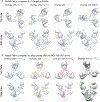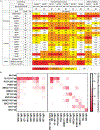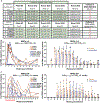Sequential immunization of macaques elicits heterologous neutralizing antibodies targeting the V3-glycan patch of HIV-1 Env
- PMID: 34818054
- PMCID: PMC8932345
- DOI: 10.1126/scitranslmed.abk1533
Sequential immunization of macaques elicits heterologous neutralizing antibodies targeting the V3-glycan patch of HIV-1 Env
Abstract
Broadly neutralizing antibodies (bNAbs) against HIV-1 develop after prolonged virus and antibody coevolution. Previous studies showed that sequential immunization with a V3-glycan patch germline-targeting HIV-1 envelope trimer (Env) followed by variant Envs can reproduce this process in mice carrying V3-glycan bNAb precursor B cells. However, eliciting bNAbs in animals with polyclonal antibody repertoires is more difficult. We used a V3-glycan immunogen multimerized on virus-like particles (VLPs), followed by boosting with increasingly native-like Env-VLPs, to elicit heterologous neutralizing antibodies in nonhuman primates (NHPs). Structures of antibody/Env complexes after prime and boost vaccinations demonstrated target epitope recognition with apparent maturation to accommodate glycans. However, we also observed increasing off-target antibodies with boosting. Eight vaccinated NHPs were subsequently challenged with simian-human immunodeficiency virus (SHIV), and seven of eight animals became infected. The single NHP that remained uninfected after viral challenge exhibited one of the lowest neutralization titers against the challenge virus. These results demonstrate that more potent heterologous neutralization resulting from sequential immunization is necessary for protection in this animal model. Thus, improved prime-boost regimens to increase bNAb potency and stimulate other immune protection mechanisms are essential for developing anti–HIV-1 vaccines.
Conflict of interest statement
Figures






Similar articles
-
HIV-1 Cross-Reactive Primary Virus Neutralizing Antibody Response Elicited by Immunization in Nonhuman Primates.J Virol. 2017 Oct 13;91(21):e00910-17. doi: 10.1128/JVI.00910-17. Print 2017 Nov 1. J Virol. 2017. PMID: 28835491 Free PMC article.
-
Vaccine Elicitation of High Mannose-Dependent Neutralizing Antibodies against the V3-Glycan Broadly Neutralizing Epitope in Nonhuman Primates.Cell Rep. 2017 Feb 28;18(9):2175-2188. doi: 10.1016/j.celrep.2017.02.003. Cell Rep. 2017. PMID: 28249163 Free PMC article.
-
Immunization of cows with HIV envelope trimers generates broadly neutralizing antibodies to the V2-apex from the ultralong CDRH3 repertoire.PLoS Pathog. 2024 Sep 9;20(9):e1012042. doi: 10.1371/journal.ppat.1012042. eCollection 2024 Sep. PLoS Pathog. 2024. PMID: 39250525 Free PMC article.
-
Structural Insights from HIV-Antibody Coevolution and Related Immunization Studies.AIDS Res Hum Retroviruses. 2018 Sep;34(9):760-768. doi: 10.1089/AID.2018.0097. Epub 2018 Aug 15. AIDS Res Hum Retroviruses. 2018. PMID: 29984587 Free PMC article. Review.
-
Strategies for induction of HIV-1 envelope-reactive broadly neutralizing antibodies.J Int AIDS Soc. 2021 Nov;24 Suppl 7(Suppl 7):e25831. doi: 10.1002/jia2.25831. J Int AIDS Soc. 2021. PMID: 34806332 Free PMC article. Review.
Cited by
-
Antigen presentation dynamics shape the response to emergent variants like SARS-CoV-2 Omicron strain after multiple vaccinations with wild type strain.bioRxiv [Preprint]. 2022 Aug 25:2022.08.24.505127. doi: 10.1101/2022.08.24.505127. bioRxiv. 2022. Update in: Cell Rep. 2023 Apr 25;42(4):112256. doi: 10.1016/j.celrep.2023.112256. PMID: 36052368 Free PMC article. Updated. Preprint.
-
Structure-guided changes at the V2 apex of HIV-1 clade C trimer enhance elicitation of autologous neutralizing and broad V1V2-scaffold antibodies.Cell Rep. 2022 Mar 1;38(9):110436. doi: 10.1016/j.celrep.2022.110436. Cell Rep. 2022. PMID: 35235790 Free PMC article.
-
HIV-1-envelope trimer transitions from prefusion-closed to CD4-bound-open conformations through an occluded-intermediate state.bioRxiv [Preprint]. 2024 Jul 17:2024.07.15.603531. doi: 10.1101/2024.07.15.603531. bioRxiv. 2024. Update in: Comput Struct Biotechnol J. 2024 Nov 12;23:4192-4204. doi: 10.1016/j.csbj.2024.11.020. PMID: 39071380 Free PMC article. Updated. Preprint.
-
mRNA-LNP HIV-1 trimer boosters elicit precursors to broad neutralizing antibodies.Science. 2024 May 17;384(6697):eadk0582. doi: 10.1126/science.adk0582. Epub 2024 May 17. Science. 2024. PMID: 38753770 Free PMC article.
-
HIV-1-envelope trimer transitions from prefusion-closed to CD4-bound-open conformations through an occluded-intermediate state.Comput Struct Biotechnol J. 2024 Nov 12;23:4192-4204. doi: 10.1016/j.csbj.2024.11.020. eCollection 2024 Dec. Comput Struct Biotechnol J. 2024. PMID: 39640534 Free PMC article.
References
-
- Baba TW et al., Human neutralizing monoclonal antibodies of the IgG1 subtype protect against mucosal simian-human immunodeficiency virus infection. Nat Med 6, 200–206 (2000). - PubMed
-
- Eichberg JW, Murthy KK, Ward RH, Prince AM, Prevention of HIV infection by passive immunization with HIVIG or CD4-IgG. AIDS Res Hum Retroviruses 8, 1515 (1992). - PubMed
-
- Emini EA et al., Prevention of HIV-1 infection in chimpanzees by gp120 V3 domain-specific monoclonal antibody. Nature 355, 728–730 (1992). - PubMed
Publication types
MeSH terms
Substances
Grants and funding
LinkOut - more resources
Full Text Sources
Medical

